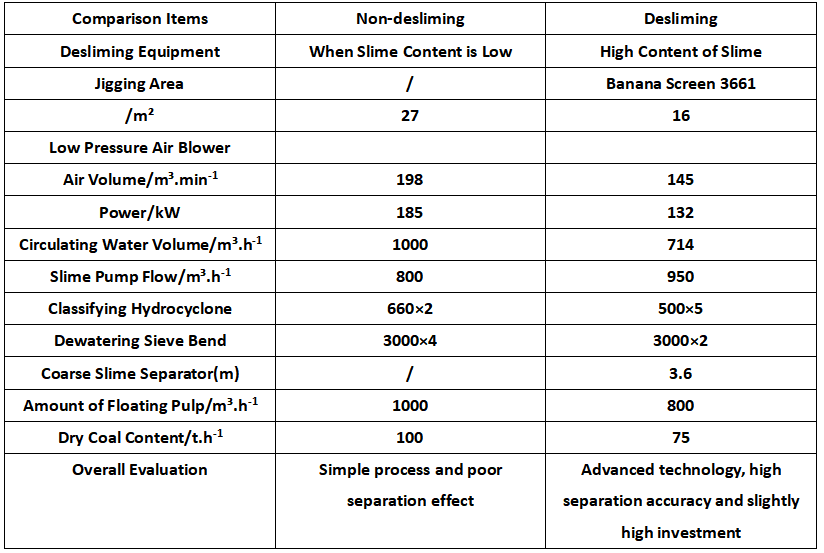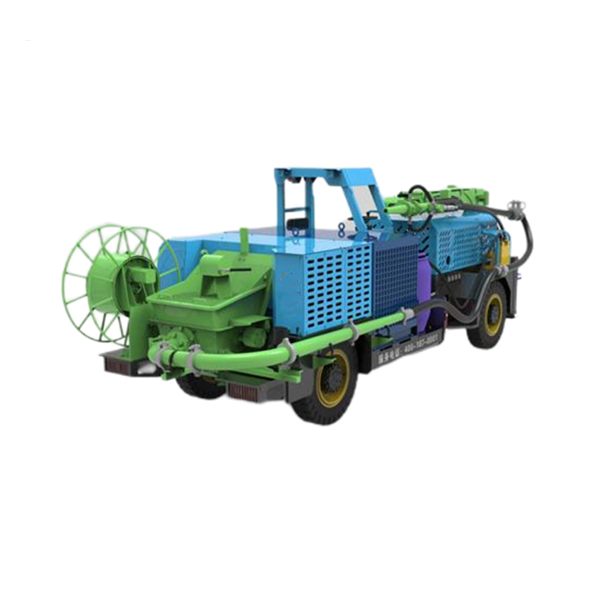
Company:China Mineral Processing & Metallurgy League
Email: sales@hot-mining.com
Phone:+86 18252116933
Fax:+86 10 58646590
Address:Room10811, Floor8, Building A, Galaxy SOHO, Dongcheng Dist, Beijing, P.R.China
Application of Desliming and Jigging Technology in a Coal Preparation Plant
Overview of Coal Preparation Plant
A coal preparation plant with a processing capacity of 1.2 million / A. It is a mine type coal preparation plant, mainly used to wash raw coal of the mine. The main coal seams of the mine are No.1, No.2 and No.9 coal seams. 1. No. 2 coal seam adopts the methods of strike long wall single coal seam and inclined layer downward natural caving mining. At present, No. 2 coal and No. 9 coal are mainly mined. No. 2 coal has the characteristics of high ash, low sulfur, good grindability and medium selection. The brand of coal is anthracite and lean coal. After washing and processing, it can be used as power coal for power plant and coal for blast furnace injection. The coal preparation process of the coal preparation plant is diacharge og lump coal , and the smalls is sold directly. The existing coal preparation process of the coal preparation plant is diacharge og lump coal, and the smalls is sold directly. With the change of market demand, the market competitiveness of products is weakened, which makes it difficult to sell coal products. Another main reason is the poor property of coal, resulting in the original smalls can not be directly sold as electric coal. Therefore, for the survival and development of the enterprise, in order to further improve the economic benefits of the enterprise, a coal preparation plant determines to realize the full washing of raw coal, improve the product property, adjust the product structure, and meet the market demand.
Preparation of Coal Preparation Process
Necessity of Desliming before Beneficiation

Combined with the site conditions, the newly added system is mainly used to wash the smalls. According to No.2 coal property data (see Table 1), the content of primary slime is 21.88%, and that of secondary slime is 46.24% if it is selected as 9%. Whether desliming is needed before separation mainly depends on the dual requirements of variable flow characteristics and stability of separation suspension. Production experience shows that with the increase of the content of pulverized coal, the separation of other particles will be reduced. According to the test , the possible deviation of material separation increases with the increase of pulverized coal content. Next, the advantages and disadvantages of desliming are compared between dense medium and jig processes.

Jigging separation. According to the jig process, the main equipment selection comparison between desliming and non desliming is as follows:
It can be seen from the comparison table that after desliming before beneficiation, the jig area is reduced by 41%, the consumption of low-pressure air is reduced by 29%, the circulating water is reduced by 29%, and the installed capacity of flotation is reduced by 30% with the decrease of pulp volume. After desliming, the coarse slime separator is used to separate the coarse slime, which improves the recovery rate of clean coal and improves the economic benefits of the enterprise. Advantages of desliming before separation: separation of thickness and fineness, separate control of separation density, obvious improvement of separation accuracy, reduction of power consumption and production cost. Disadvantages: the process is complex and the construction investment is relatively high. After comprehensive comparison, desliming process before beneficiation is designed.

The determination of coal preparation method "the coal preparation method shall be determined according to the product requirements, separation efficiency, sales revenue, production cost, infrastructure investment and other relevant factors of raw coal properties (such as particle size composition, density composition, washability, floatability, sulfur composition and occurrence characteristics, gangue lithology), after comprehensive comparison of technology and economy." Combined with the actual situation of the plant, through comparison and calculation of various schemes, jigging is considered comprehensively. The final process is the combined process of desliming jigging + coarse slime separation + flotation + concentration and pressure filtration.
Problems and Solutions during Commissioning
Jigging separation effect is not ideal in the case of ensuring the stability of raw coal feeding, jigging the middle gangue belt coal is more serious. When the ash content of the clean coal product is stable below 14%, the gangue belt coal is more than 6%, the middle coal belt coal is basically between 10% - 20%, up to 30%. Through the analysis of the site, the solutions are as follows: ① install the artificial bed; ② install four 40mm high baffles in the first section of the jig; ③ adjust the overflow weir; ④ change the air valve cycle to multi frequency to improve the separation effect of the jig. Through the above measures, the amount of coal in the middle gangue belt is effectively controlled to achieve the expected effect of the design. The amount of coal in the gangue belt is less than 4%, and the amount of coal in the middle coal belt is less than 10%.
After 1 mm desliming, the raw coal with unsatisfactory classification hydrocyclone will enter the jig separation system on the screen, and the water from the screen will enter the slime bucket and be delivered to the classification hydrocyclone by pump. The overflow of hydrocyclone will enter the flotation system, and the underflow will enter the coarse slime separation system. The feed of hydrocyclone shall come from the water from desliming screen, jigging coal dewatering screen, CSS sieve bend (refer to the water from pre dewatering sieve bend overflowed by Coarse Slime Separator, hereinafter referred to as CSS sieve bend water) and centrifugal liquid (CSS sieve bend water and centrifugal liquid are mainly considered to enter into flotation directly. However, considering that the centrifuge may run rough, the bypass into the hydrocyclone is designed). During the trial operation, the classification effect of hydrocyclone is also feasible. It is found that after the centrifuge runs rough, the water from CSS sieve bend and the centrifugal liquid (i.e. the filtrate barrel feed) are fed into the hydrocyclone for classification. It is found that the fine mud content in the hydrocyclone feed is obviously increased, and the content of - 0.28mm reaches 83.25% at the high level, resulting in the fine mud content (- 0.28mm) in the bottom flow of the hydrocyclone exceeding 60%, The separation effect of Coarse Slime Separator is seriously affected.After analysis, the following solutions are put forward: Plan 1: replace the classification hydrocyclone. Due to the large amount of actual slime, the original hydrocyclone can not meet the classification requirements. According to the actual measured slime data, the classification hydrocyclone can be customized to solve the problem of too much slime in the underflow of hydrocyclone. However, due to the two kinds of coal washed in our plant, the coal quality is not stable, which will also affect the classification effect of the hydrocyclone. Scheme 2: untie the "small circulation of fine mud". Through the actual measurement and comparison of each source in the hydrocyclone feed, it is found that the fine slime mainly comes from the CSS sieve bend water, which is equivalent to a small cycle of "slime bucket hydrocyclone CSS sieve bend slime bucket". Therefore, it is considered to separate the centrifuge filtrate from the CSS curved screen water, and the CSS curved screen water will directly enter the flotation, and the centrifuge filtrate will enter the hydrocyclone. Scheme 3: a new type of ISB vibrating mesh sieve bend is adopted for coarse slime grading and desliming. Through analysis, this phenomenon appears in the original design. The surface phenomenon is caused by the running of centrifuge, and the root cause is that the grading desliming equipment can not achieve the desired effect. Therefore, it can be considered to change the hydrocyclone into a vibrating sieve bend to ensure the floating particle size. After analysis, the following solutions are put forward: Plan 1: replace the classification hydrocyclone. Due to the large amount of actual slime, the original hydrocyclone can not meet the classification requirements. According to the actual measured slime data, the classification hydrocyclone can be customized to solve the problem of too much slime in the underflow of hydrocyclone. However, due to the two kinds of coal washed in our plant, the coal quality is not stable, which will also affect the classification effect of the hydrocyclone. Scheme 2: untie the "small circulation of fine mud". Through the actual measurement and comparison of each source in the hydrocyclone feed, it is found that the fine slime mainly comes from the CSS sieve bend water, which is equivalent to a small cycle of "slime bucket hydrocyclone CSS sieve bend slime bucket". Therefore, it is considered to separate the centrifuge filtrate from the CSS curved screen water, and the CSS curved screen water will directly enter the flotation, and the centrifuge filtrate will enter the hydrocyclone. Scheme 3: a new type of ISB vibrating mesh sieve bend is adopted for coarse slime grading and desliming. Through analysis, this phenomenon appears in the original design. The surface phenomenon is caused by the running of centrifuge, and the root cause is that the grading desliming equipment can not achieve the desired effect. Therefore, it can be considered to change the hydrocyclone into a vibrating sieve bend to ensure the floating particle size.
Conclusion
With the development of modern mechanical mining, the proportion of pulverized coal in raw coal is higher and higher, and the entry of a large number of slime brings a great challenge to the coal preparation plant. The success or failure of a coal preparation plant depends on the smoothness of the slime water system. Through practical application in the Preparation Plant, the desliming jigging process not only solves the problem of large amount of slime, but also improves the separation effect of jigger, injects new vitality into the development of jigging process, and provides a model for the implementation of desliming jigging process.
If you're interested, pls just contact us:
Liv Wang
Tari Wang
E-mail
liv.wang@hot-mining.com
tari.wang@hot-mining.com
Tel
+86 18227011092
+86 15927439651
|
|
Liv Wang |
Tari Wang |
|
|
|
liv.wang@hot-mining.com |
tari.wang@hot-mining.com |
|
|
Tel |
+86 18227011092 |
+86 15927439651 |
|
Please feel free to give your inquiry in the form below.We will reply you in 24 hours.

























